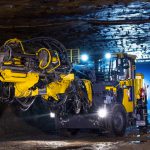
Interrogating mining sector risks
Mining is the primary extraction of economic minerals from the ground and processing them to a saleable form.
The earth’s crust has many, different, economic minerals which also have a wide range of economic value. From coal and tin to diamonds and gold – the range of values is vast. Obviously the higher the value the smaller the piece one can spirit away to gain some economic benefit. In summary, one would need to steal tonnes of coal to realize the same value in an ounce of gold or a few carats of diamonds. This makes all mining operations highly risky in terms of securing the main product of the operations.
Any high value mining operation always has someone or a group of people scheming to illicitly remove minerals from the mine for personal benefit. It is a reality that there is always someone with the temptation to ‘beat the system’ and get rich quick. These people study the whole value chain to see where they can strike and get away with it. In many cases, syndicates become so well organized that this becomes a way of life for them. Some steal from the underground operational sites, while others steal from the processing plants.
The daring ones steal at the point where the mineral is at its highest value before leaving the mine, like the gold smelter room. One of the biggest security challenges is when there is collusion between the ordinary mine employees and the security guards – a typical situation of the Latin “Qui custodiet ipsos custodes?” – Who will guard the guards?
How can the bad apples be caught? Many mines conduct perfunctory body searches at their exit points. Some have taken their detection systems up a notch to include metal detectors (if they really work) and scanners at the exit points.

Increasingly, mining operations are installing Closed-circuit TV (CCTV) monitoring. On one sophisticated high value mine, more than 400 cameras are deployed and the mine’s entire operations can be viewed remotely by the security service personnel and senior management. There are also very strict protocols about dropping and picking items on some high-value mines, such that if one accidentally (or deliberately) drops anything, they are not allowed to pick it up themselves – instead, they call upon a member of the security team who will only pick up the dropped item after doing a 360 degree show of his hands before and after picking (to show cameras at different angles that his hands have nothing else on them). On one gemstone mine which I visited a few years ago, they even had a lie-detector! If you picked a red ball (there were red and green balls in a box), then you were put on the lie-detector.
Strangely enough, all the high tech systems, largely fail to detect the security breaches and the culprits only get caught through ‘lifestyle audits’. On one mine, there was an employee who threw parties every weekend under the pretext of birthday parties for members of his family. When he had his party, the wife’s party and all the children’s parties, he could not resist throwing a party for his brother who was back at the village, in his absence! In some cases, employees are seen to be ‘living beyond their means’ and buying flashy cars and top of the range furniture. In some cases, the wives and children begin showing off and it triggers investigation. Where CCTV systems are installed, it is very important to have a review mechanism where the footage can be reviewed for security breaches – otherwise it just becomes a wastage investment in security.

So with all these high-tech systems, has theft of high value minerals stopped? Not at all. Human beings never tire of thinking up new ways to beat the system. In many cases where the offenders are caught, it is pure luck on the management’s part or sloppiness on their (culprits) part. When I was Mine Manager on a certain gold operation, I asked the Security Manager why there were no cases, even of suspected theft. After a number of such inquiries, I later discovered that he had previously done his job and had been left compromised. This had caused him to become less aggressive in his work. As said earlier, on any mine, there is always someone stealing or plotting to steal.Unfortunately, many people think only the high value mineral is being stolen. In reality, people steal anything that can be translated to a monetary value.
What other items pose security risks on mines? Bearings, welding rods, PPE or even stationery are items which get stolen from the mines. While their values do not match the value of mineral theft, any theft represents loss of value to the enterprise. This means the security personnel on a mine must not just be looking out for a stone or concentrates in an employee’s back pocket. Their eyes must be open to see any items being removed from the mine without proper authorization.
Operations with large earth-moving fleets are often targets of fuel and oil theft. There is need to put in place systems that make it difficult to drain fuel and sell on the black market where there is a ready market. On some mines, even car batteries or tyres have been stolen!
The main objective of management of any economic enterprise, is to maximize shareholder value. On mining operations, the direct erosion of shareholder value occurs when there is theft of the high value mineral that the mine earns revenue from. However, management must remain alive to the reality that other forms of theft are possible, on a mine, and hence need to continue to develop systems to keep such security breaches in check.


